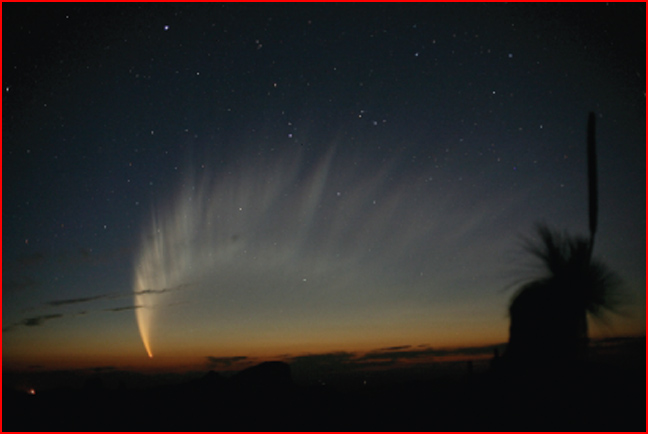
home •
about •
essential guide •
picture of the day •
thunderblogs •
news •
multimedia •
predictions •
products •
get involved •
contact
picture of the day archive subject index
Comet McNaught. Photo by its discoverer, R. H. McNaught, Siding Spring Observatory
Oct 05, 2007
Comet McNaught Modulates the Solar Wind
A deceleration in the solar wind velocity has been detected by the Ulysses space probe. Could the electrical effects of a single comet be the cause?A recent announcement by the University of Michigan has astronomers wondering at the strong influence from comet McNaught on the velocity of the ionic bombardment emitted by the sun. Called the "solar wind," the steam of energetic ions is not really a wind but is primarily a collection of atoms whose electrons have been stripped from the nuclei, leaving positively charged particles. The charged particles are accelerated to high velocities - approximately 750 kilometers per second within the solar system, radiating out in the direction of the sun's magnetic field.
On October 6, 1990, the space shuttle Discovery launched the Ulysses spacecraft on a mission to study the sun's north and south polar magnetic fields. Because it is in an unusual orbit at such high latitudes, Ulysses encountered comet McNaught while it was passing near the planet Mars. Stretching approximately 160 million kilometers from its nucleus, the comet's charged tail seems to have reduced the solar wind velocity and caused a stir among scientists.
According to Dr. Michael Combi, a University of Michigan space science professor:
"This was very surprising to me. Way past the orbit of Mars, the solar wind felt the disturbance of this little comet. It will be a serious challenge for us theoreticians and computer modelers to figure out the physics."
The Solar Wind Ion Composition Experiment (SWICS) found that the tail had slowed the solar wind to half its normal speed. The solar wind would usually be about 700 kilometers per second at that distance from the sun, but inside the comet's ion tail, it was less than 350 kilometers per second.
The physics are not so challenging to the proponents of an Electric Universe. Cometary ion tails always point away from the sun, because comets are the foci of electrical discharges in a weak, radial solar electric field. As they gradually move closer to the sun, their electric charges become increasingly negative with respect to the solar plasma. Comets lose mass in the form of extremely fine dust and negatively charged ions through a process called cathode sputtering, so their disturbance in the solar plasma is far greater than can be explained by inert objects. The negative charge in the comets and in their tails attracts nearby solar wind protons, decelerating them in the vicinity and causing an overall deceleration of the solar wind.
Unfortunately, most astronomical investigators are unfamiliar with the electrical component to our sun's environment (and the environment of space itself), so they fail to explain the evidence.
Said George Gloeckler, second author of a paper on the findings published October 1, 2007, in Astrophysical Journal:
"The benefits of such an observation are important, they constrain the interactions of such comets with the sun, including how the comets lose mass. They also examine the question of how a sudden injection of neutral and cold material interacts with hot solar-like plasmas."
As we have written in previous Thunderbolts Picture of the Day articles, electrically neutral bodies do not exist in the universe. Mistaking plasma for hot gas and adhering to traditional gravity-only explanations is what prevents the proper understanding of comets and why they act the way they do. It also explains why the solar system continues to confound standard theories.
By Stephen Smith
___________________________________________________________________________Please visit our Forum
The Electric Sky and The Electric Universe available now!

|
|

|
EXECUTIVE EDITORS:
David Talbott, Wallace Thornhill
MANAGING EDITORS:
Steve Smith, Mel Acheson
CONTRIBUTING EDITORS: Michael Armstrong, Dwardu Cardona,
Ev Cochrane,
C.J. Ransom, Don Scott, Rens van der Sluijs, Ian Tresman
WEBMASTER: Brian Talbott
Copyright 2007: thunderbolts.info
![]()
home •
thunderblogs •
forum •
picture of the day •
resources •
team •
updates •
contact us

